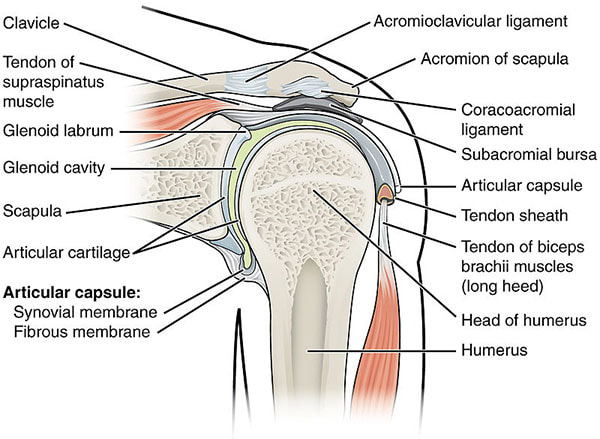|
SEARCH My Blog (Opens in new tab)
I never thought that it would happen to me Photo by Akim Young on Unsplash Suddenly your shoulder clicks and you are in a land of pain whenever you move out of a minimal range of motion with your arm. I know. It happened to me. I was doing nothing more than brushing my hair. As President Trump would say, it's a horrible thing. Movements which were previously unconscious and innocuous suddenly produce shrieking bone pain which can start in your lower arm and run up to your shoulder. (Ah! I just had a twitch then!) Shoulder pain or tightness is common, affecting 18 to 26 per cent of adults. And frozen shoulder - the most severe impingement - is estimated to affect 2%–5% of the general population, and can be significantly painful and disabling. To be honest, I did not see myself as a likely candidate for shoulder impingement. Sudden impairment can be caused by prior traumaI have strong shoulders from exercising with kettlebells for 25 years and from rowing 1.5km three times a week. At least that's what I did before the gyms closed down. But one thing that gradually catches up is our tendons tightening with age or arthritis developing. Prior accidents are also be associated with a sudden onset of shoulder pain. Upon reflection, I think accidents that may be the cause of my condition. A few years ago, I broke a slow fall from my bike with my outstretched left arm. I didn't feel any pain, but minor traumas to muscles, tendons, and ligaments in the shoulder can remain hidden. I also ran into a tree branch with my left shoulder while trail running and not paying attention. The impact spun me around, and later my shoulder went black. Probably the health and strength of my shoulders protected me, until I lost access to the gym and those regular exercises which had kept things in place for so long. When you have a sudden onset of shoulder pain, there is a good chance that you can work through it, over time, and recover the prior pain-free movement. When pain develops gradually over time, it requires more specific professional diagnosis. What causes shoulder pain?Impingement, a common cause of shoulder pain, occurs when one of the muscles of the rotator cuff is weakened or torn. The weakened muscle fails to hold the ball of the humerus firmly in place when you lift your arm. Then, as you move, the humerus shifts slightly upward, pressing against a ridge on the shoulder blade. This obstruction can cause a pinching sensation, piercing pain, or weakness each time you move your arm, rotate it, or raise it above your head, for example. The pain may be worse at night, mine is. And it can suddenly hurt when you roll over or even gently change the position of your arm. causes shoulder pain Initial treatmentUnfortunately, even the least severe cases of impaired shoulder movement take between 5 months and 3 years to return to a pain-free full range of motion. Mine is a lot better, after 2 months. I followed the time-honoured methods that are relevant to a direct cause and effect of shoulder pain (such as a heavy bout of spring cleaning or a vigorous tennis match). These methods include:
I believe that these treatments have enabled me to regain a good range of pain-free motion. I also do several of these exercises during the day. 12 shoulder stretches and strengthening exercisesStop if any of these cause you pain. Find others that do not cause you pain, or talk with your doctor. Don't mess with your shoulder. These are all exercises that I do. I favour the simple ones such as the Pendulum stretch to ease any pains before doing the strength movements. #1 Pendulum stretch Do this exercise first. Relax your shoulders. Stand and lean over slightly, allowing the affected arm to hang down. Swing the arm in a small circle about a forearm length in diameter. Perform 10 revolutions in each direction, once a day. As your symptoms improve, increase the diameter of your swing, but never force it. When you're ready for more, increase the stretch by holding a light weight (1 to 3kg) in your swinging arm. I also swing the good arm, as the movement in the good arm helps heal the impaired one. #2 Pec stretch and strengthen Sit on the ground. Put your legs out to the side with your knees bent and the soles of your feet together. Keep your back straight put your elbows on your thighs or your knees and push towards the ground with your forearms. Hold for 8 to 10 seconds. This is a strengthening stretch, an isometric exercise. Repeat 3 to 5 times. #3 Lats stretch This one is a classic shoulder stretch. Stand next to a door frame with your elbow by your side and bent out at 90°. Rotate your body forwards, keeping your elbow by your side until you feel a stretch in the front of your shoulder. Hold for 10 to 15 seconds. Repeat 5 to 10 times. #4 Sustained on-floor stretch and strengthen Lie on your back with your elbow by your side and bent out to 90°. Wedge your hand under a fixed item and keep your shoulder flat on the ground. Hold the tension for about 8 seconds, then release completely. Repeat 3 to 5 times. #5 Pillow stretch Lie on your back with your knees bent up and place a pillow under your thoracic spine (lower neck and upper shoulders) and relax over it. Hold for 10 to 20 seconds. Beginner – arms crossed over chest. Advanced – arms behind head - all pain-free. #6 Towel stretch Hold one end of a three-foot-long towel behind your back and grab the opposite end with your other hand. Hold the towel in a horizontal position. Use your good arm to pull the affected arm upward to stretch it. You can also do an advanced version of this exercise with the towel draped over your good shoulder. Hold the bottom of the towel with the affected arm and pull it toward the lower back with the unaffected arm. Do this 10 to 20 times a day. Source: (health.harvard.edu) #7 Forearm inward rotation stretch and strengthen Hold a rubber exercise band between your hands with your elbows at a 90-degree angle close to your sides. Rotate the lower part of the affected arm outwards two or three inches and hold for five seconds. Repeat 10 to 15 times, once a day. #8 Forearm outward rotation stretch and strengthen Stand next to a closed door, and hook one end of a rubber exercise band around the doorknob. Hold the other end with the hand of the affected arm, holding your elbow at a 90-degree angle. Pull the band inwards towards your body two or three inches and hold for five seconds. Repeat 10 to 15 times, once a day. #9 Floor forward shoulder stretch Lie on your stomach with your arms at your sides. Put a pillow under your forehead if you need to. Allow your shoulders to relax downwards into the floor thoroughly. Breath and rest calmly for 20 seconds. Repeat as required during the day. #10 Forward head drop - stretch This stretch will relieve tension in your neck which radiates out to your shoulders. Place your hands on the base of your neck with your elbows pointed out to the sides. Stand up tall and take a deep breath, and then exhale as you drop your chin towards your chest, pulling your elbows down towards the floor. Gently allow the weight of your hands and arms to weigh your head down further, and take a few deep breaths here. Repeat 2 to 5 times. Two no-equipment shoulder strengthening exercisesHere are two examples of pure strengthening exercises that help prevent shoulder pain using little to no equipment. #11 Straight-arm front raise Fill a 1-litre water bottle, or grab a 1kg bag of rice. Keeping your arm straight, hold the weight in front of you at shoulder height for 30 to 60 seconds. This is harder than it seems! Switch arms - do this three times for each arm. #12 Shoulder isometric contraction Lie on your stomach with your arms at your sides. Put a pillow under your forehead if you need to. Gently bring your shoulder blades together and pull them toward your feet. Relax your shoulders about halfway down and hold for 10 seconds. Release your shoulders completely, and then repeat the exercise 10 times. Go gentlyIt's an old story. You don't realise how wonderful it is to have freely moving shoulders until you've lost it. As you rehabilitate your sore shoulder, take a look at what you do routinely and make some little changes to prevent any setbacks:
I'm taking things carefully, being cautious to avoid setbacks. For me, this includes still using kettlebells as part of my shoulder rehabilitation but I don’t recommend that you do this. If you have a sore shoulder, I wish you well. Keep moving carefully. Vera Lynn said, "we'll meet again". Hopefully, we'll sleep again - without shoulder pain. Good luck. > More posts to help you with EXERCISES > More posts to help you with DIABETES > If you are a @MEDIUM reader my publication Body Age Buster has hundreds of categorised posts which I have written especially for men and women over 50. Follow me on Quora for more health and fitness tips.
If you valued this article >> Follow me Leave a comment >> Share it >> Stay healthy If you have any questions email me and I will get back to you. Latest: get your free customised fitness plan designed uniquely for you.
|
ChoicesSince I was diagnosed at 50 with Type 2 diabetes I've been learning how to do bone-building fitness training which lowers my age. You can too. It's your choice. Walter Categories
All
Archives
May 2023
|

 RSS Feed
RSS Feed 


